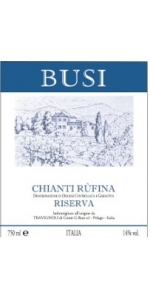Wine from Rufina
Rufina is one of the Italian communes in the Provence of Florence, in the Tuscany region. Rufina is the area that produces Chianti Rufina, and while it is the smallest sub zone for Chianti, it boasts a reputation of being one of the best. Rufina’s location in Central Italy situates on the hills overlooking the Sieve River. Rufina is fortunate to experience a continental climate, consisting of lengthy, hot summers with little precipitation that produce excellent soils. The heat allows for a more a full-bodied wine, while the cool nights that Rufina experiences foster flavor development and help to retain acidity. Rufina is approximately 1312 feet above sea level, which creates an ideal environment for growing the Sangiovese grape. The Chianti produced in Rufina will have excellent structure due to the higher acidity and display refined fruit throughout.
Busi Chianti Rufina Riserva is made from 100% Sangiovese
Vineyards: Travignoli, a name which literally means “Tra Vignoli” (between the vineyards) is located in the middle of Frescobaldi’s Nipozzano vineyard in the heart of the Rufina zone. There is documented evidence that wine was first produced there in the 5th C BC by the Etruscans who called it “Nectar of the Gods”. The Church acquired the land and constructed the cellars in 1100.
Count Busi and his family acquired the estate in the 1800’s. Overall, 91
hectares belong to the estate. The 60 hectares of vineyards are excellently
position on the slopes with a southerly exposure at an elevation between 270 to 370 meters. Clay, marl and calcareous soil with a large percentage of rocks and stones for good drainage. Vines are an average of 10–25 years old.
Harvest: October– by hand.
Yield per hectare: 40 Quintals per hectare
Vinification: Fermentation in stainless steel at controlled temperatures for 7 to 8 days with an additional 7 to 8 days on the skins. The wine is then racked and goes through malolactic. It is then racked again and stays another 3 months in stainless steel.
Aging: 25 to 30 hectoliter barrels of Slavonian oak for 18 months and 3 months in Allier barriques. There is a period of refinement of 4 to 5 months in the bottle.
Alcohol: 13% by vol.
Color: Ruby red with garnet reflections.
Bouquet: Intense, ethereal bouquet with hints of leather, tar and ripe cherry fruit.
Taste: The flavor is full of mature fruit with nuances of leather and liquorice. The taste is complex and round and rich with character. The finish is persistent and satisfying.
Foods: Grilled, braised or roasted meats, dishes flavored with mushrooms, or rosemary. Excellent with polenta dishes.
Total Production: 3,300 cases
Enologist: Mauro Orsoni
- back
Selected Options
Regions
Categories
Pricing
Countries
Regions
Grape Types
Wineries
Organic/Free Shipping
Damilano Barolo Cannubi is made from 100 percent Nebbiolo.
Garnet ruby red in color with orange reflections. The bouquet is ample and embracing, with pronounced fruity notes of cherry and plum and notes of tobacco, licorice and cocoa. On the palate, the wine is harmonious, pleasantly dry with soft tannins, broad and full-bodied. Persistent finish.
Cannubi is a sumptuous wine, perfect with the full-flavored Piedmontese cuisine such as white truffle -based dishes and braised meat. Ideal with the refined dishes of the great international gastronomy.
Review:
Sweet berries, tar and hazelnuts on the nose with some iodine and dry earth. Full-bodied with a solid center palate of juicy fruit and powerful, fine tannins. It’s racy and very long. Needs time to soften. Better after 2023.
-James Suckling 96 Points
A polished wine with charming layers of fruit and complexity. The enchanting aromas of red cherry, rambutan, strawberry, and rose develop and open into a deeply flavoured palate. A velvety wrap of tannins surrounds the dark plums and morello cherry and a light dusting of vanilla.
-Decanter 97 Points
Quercia nelle Langhe Nebbiolo Langhe is 100% Nebbiolo.
Garnet red, bouquet is fruity with reminiscences of violets and raspberries.
Full bodied, interesting and intense.
Manual Harvest at the beginning of October.
The grapes are delicately pressed and the stalks are removed. The limpid must ferment in stainless steel vats at a controlled temperature of 26°C for 12 days. After racking the new wine is put into 25 and 30 hl Slavonian oak barrels for long months. Next, it is bottled for reaching the market.
Pairs well with ribeye, red meats.





